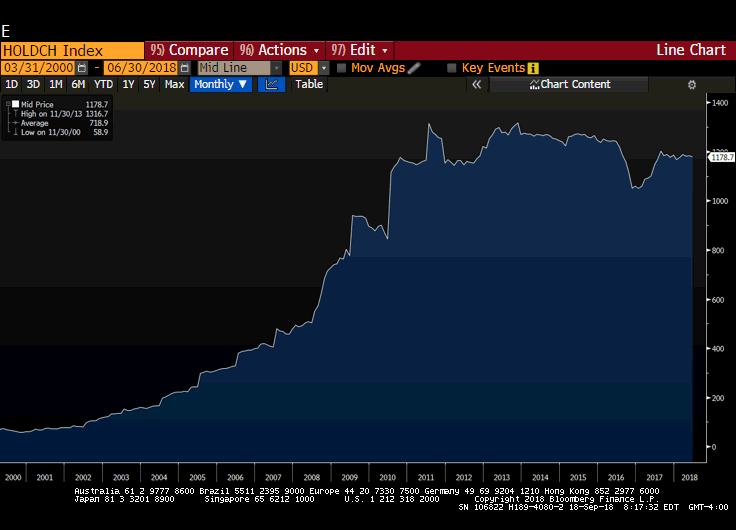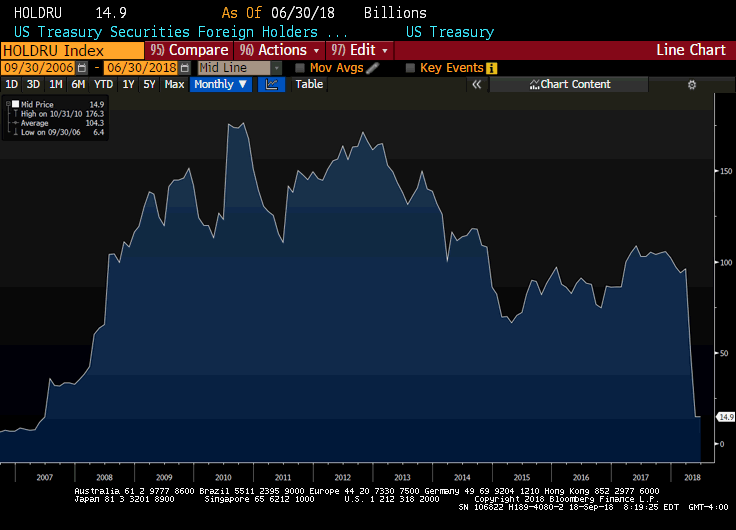President Trump upped the ante in the U.S.-China trade war this week, vowing to slap new tariffs on $200 billion of imported Chinese goods. A 10% levy will start Sept. 24. Here are investing implications for bonds, says Mike Larson, who's presenting at MoneyShow Dallas.
Depending on how China reacts, it could rise to 25% by year end,
China responded by saying it “has no choice but to undertake synchronous retaliation,” announcing 5% to 10% tariffs of its own on $60 billion of U.S. goods. Trump countered by saying he’d slap duties on an additional $267 billion in Chinese goods if they didn’t back down. That would result in almost every single imported Chinese product covered with one tariff or another by early 2019.
Many U.S. businesses have complained about the tariffs. Yet the president has felt emboldened to keep the pressure on.
One reason: U.S. economic data keeps coming in strong.
Another: U.S. markets keep chugging along even as Chinese markets suffer. The Shanghai Composite Index just sank to its lowest level since 2014, putting it on track to lose value for four straight quarters. That hasn’t happened since the depths of the global bear market in 2008.
But is there a “Trump Card” that the Chinese government could soon play? One that would hit the U.S. where it hurts most?
For the answer, take a look at this chart. It’s a monthly one with data that goes all the way back to 2000.

What does it show? Chinese holdings of U.S. Treasuries, as reported by the Treasury International Capital (TIC) system. You can see that the country has accumulated a truly massive pile of U.S. bills, notes, and bonds – around $1.18 trillion as of June.
That makes it the single-largest foreign holder of U.S. debt. Japan is next up with $1.03 trillion, while Brazil is a distant third at $300 billion.
For the longest time, the threat of Asian selling has hovered over the U.S. debt market like a Sword of Damocles. But investors have always assumed the sword will never fall.
Why? Because if China started selling tens of billions of dollars in bonds, the hundreds of billions of dollars in bonds it still owned would tank in value! The country would be cutting off its nose to spite its face.
But what if China decided it really has had enough? That bond market losses were a price it was willing to pay to bend the U.S. to its will? After all, if there’s one way to stick it to the U.S., it’s to drive bond prices down and interest rates up. That’s because our country runs gigantic budget deficits and has to issue massive amounts of Treasuries to finance them.
Since government bond yields serve as benchmarks used to price other kinds of bonds and loans, the private debt market wouldn’t go unscathed. The cost of financing plant upgrades or constructing new corporate office buildings would rise. Borrowing to buy back shares, or to acquire competitors, would get more expensive. Home mortgages would cost more, as would auto and personal loans.
It’s not a pretty picture, is it? And what’s interesting is that another foreign creditor with whom we’ve tussled has already decided to take this very step! I’m talking about Russia.
This chart shows Russian holdings of U.S. Treasuries going all the way back to 2006. You can see how they plummeted this spring, dropping by $47.3 billion in April and another $33.8 billion in May. In fact, at just $14.9 billion at last count, they’re down a whopping 85% year-over-year to the lowest level in more than a decade.

Media reports suggested the selling of Treasuries, and large purchases of gold around the same time, were no accidents. They were conscious moves by Russia. The country wanted to reduce the pain from U.S.-led sanctions and reduce its exposure to the U.S. dollar and debt markets.
If China goes down the same path, the ramifications for U.S. bonds and other asset markets would be serious. That’s especially true because it would come on top of the “quiet selling” we’ve seen for several quarters in Japan. The $1.03 trillion in Treasuries that country held as of June is still a lot, sure. But it’s down $211 billion from the 2014 peak, and the lowest level in almost seven years.
Bottom line: Keep your eye on the bond market, and the news out of China. Stick with mostly shorter-term bonds or bond funds, as well as income-generating stocks that pay heftier yields and that offer protection against volatility and/or economic disruption. Because if China plays its Trump Card, serious turmoil could be headed our way.
Until next time,
Mike Larson
Join me at the MoneyShow Dallas Oct. 4-5. You can see my speaking schedule, and get registered for free here.
Check out Mike’s short video, 2 Safe Yield Stock Picks at MoneyShow San Francisco here.
Duration: 4:42.
Recorded: August 24, 2018.
Check out Mike’s short video interview, Conservative Stock Picks for 2018 at MoneyShow Las Vegas here.
Duration: 3:33
Recorded: May 14, 2018
Check out Mike’s short video interview What Investors Are Doing Wrong and How to Fix It at MoneyShow Las Vegas here:
Duration: 2:22
Recorded: May 14, 2018.





















